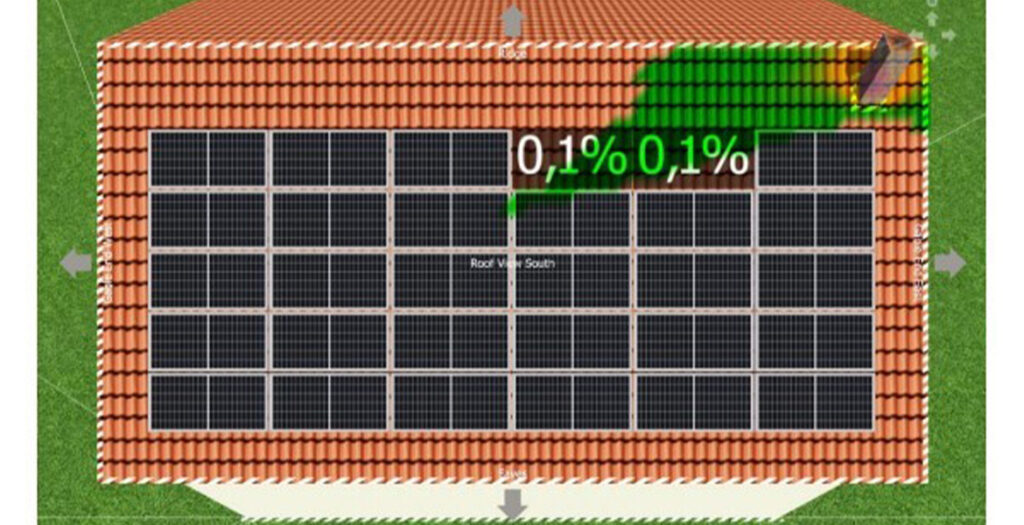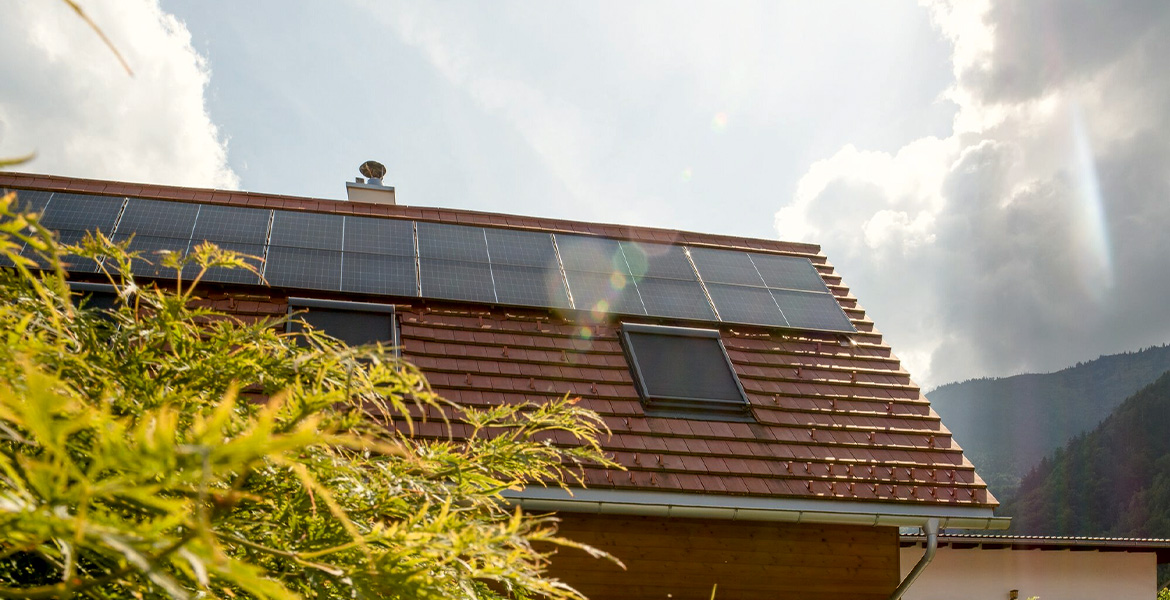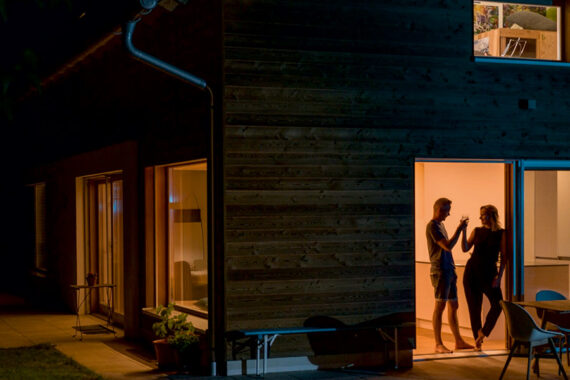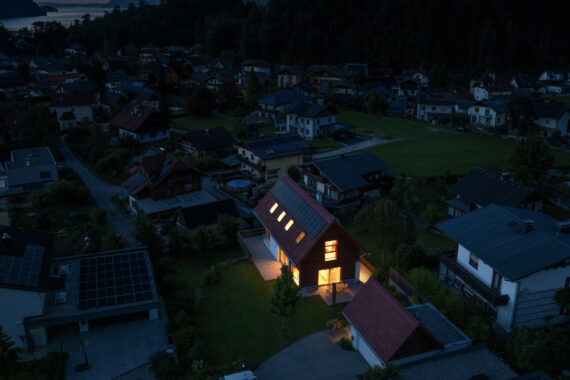More sun equals more solar power. Anyone planning their own PV system on the roof should look into the best conditions for their installation, to make sure the system works perfectly and generates optimum yields. The shading of solar modules continues to be one of the main factors preventing this, although smart developments on the solar market have started to cast shade on this issue. Read on to find out why the partial shading of solar modules now only has a negligible effect on a photovoltaic system’s yield.
Bright sunshine, not a cloud in the sky, and a PV system on the roof—these are the ideal conditions for producing as much solar energy as possible for the home. But very few roofs are completely free of shade.
Trees, masts, house antennas, and neighboring buildings often cast shadows on solar modules, supposedly resulting in a lower output and yield. However, a closer look shows that irregular shading only has a minor effect on the total yield of your PV system over the course of the year; what really counts is choosing the right inverter and opting for the correct solar module design. This is where the so-called FC factor comes into play:
What is the FC factor?
The FC factor (also known as the shading loss factor or derating factor for shading) describes the influence of shading on the performance of a PV system.
The fill correction factor (FC factor) indicates the extent to which a shaded solar module’s actual output is reduced compared to the output without shading, and is calculated using software-supported simulations or on the basis of empirical values and calculation tables.
The shading loss factor is used in the yield forecast and in particular when planning complex PV systems to calculate realistic values for the energy yield. It takes into account the orientation and inclination of the solar modules, as well as their interconnection and the type of shade (e.g., localized spots of shade, shading across a larger surface area, temporary shade).
It is usually specified as a percentage or a dimensionless value between 0 and 1.
FC = 1 → no shading, full output
FC < 1 → shading is present, reduced output
For example, if a solar module is partially shaded by a tree and can therefore only produce 80% of its original output, the FC factor is 0.8. However, it’s possible to get around this issue—read on to find out how!
A stubborn myth disproved
“If solar modules are shaded (for example by leaves), this means that the entire PV system is no longer able to produce power, or can only produce very little power. It’s like a garden hose that outputs no or very little water, regardless of where it is kinked.”
This claim is still widespread, but has long been outdated because the solution is already integrated in every solar module—in the form of bypass diodes.
Hitting the target with bypass diodes
Today, a modern photovoltaic module is generally equipped with bypass diodes, which serve as bridging devices: if certain areas of a solar module are unable to deliver full power—for example due to shading or soiling—bypass diodes ensure that the current bypasses the affected cell strings.
So exactly does this work? Changing the DC voltage of the inverter, which is applied to the string, activates the bypass diodes making them conductive; the affected cell string of the affected PV module is thereby bridged.
This means the other module areas remain fully operational and the entire system can continue to work efficiently. “This has two advantages,” explains Marija Milosavljeva, Product Manager at Fronius. “On the one hand overheating and possible hot spots are prevented, while on the other hand a profitable yield is generated despite partial shading.”
Improvements on the solar module market
Ongoing developments in solar modules are also helping to make the photovoltaic system on your roof even more cost effective:
Thanks to half-cell technology—i.e. halving the individual solar cells—conventional half-cell modules can not only reduce power losses, but also make better use of the light. This enables module operation to remain stable even at high temperatures.
Furthermore, shading behavior is also better with half-cell modules: bypass diodes divide the solar modules in the middle. This means that if the lower or upper half of the half-cell module is shaded by leaves, for example, the other half of the module can still deliver full power. By comparison, if a full-cell module were to be shaded in exactly the same way, the output of the entire solar module would be lost.

Efficient MPP solar trackers for more power
In order to keep shading losses or mismatch losses as low as possible, string or multi-string inverters are equipped with one or more MPP trackers (Maximum Power Point Trackers). Ideally, one MPP tracker is used per string; this continuously determines the optimum operating point of the connected strings and in doing so maintains the maximum power of the PV system at all times.
Complete with shading management
Maximum yield despite partial shading? Smart shading management, which is ideally already integrated in the inverter, is able to ensure this; meaning that even roof surfaces with partial shading can be optimally configured.
Our Dynamic Peak Manager is an intelligent MPP tracking algorithm that detects shading and optimizes the yield at string level. To do this, the algorithm scans and analyzes the entire voltage-power curve at regular intervals of around 10 minutes and always finds the most efficient operating point (Global Maximum Power Point) of the PV system.
Marija Milosavljeva, expert in system development at Fronius
Not all shading losses are equal
Example: Shade from a chimney
Shading simulation using independent simulation software shows that the annual shading losses are low.
As such, it’s essentially necessary to consider two different loss categories.
Module-specific partial shading losses: Sunlight is blocked by various objects that cast shadows—in this case a chimney—and less light falls on the solar modules. This reduced incidence of light cannot be optimized by any inverter, power optimizer, or microinverter. In this case, the only solution is to remove the shadow-causing object itself.
Contrastingly, mismatch losses—i.e. shading losses of strings—can be significantly improved by an intelligent MPP solar tracker algorithm. As the table shows, the mismatch losses are around two thirds lower than the shading losses at module level thanks to Dynamic Peak Manager.
| Type of shading losses | Losses in % | Losses in kWh | |
| Module-specific partial shading | –0.18 % | 26.07 kWh (of 14,485 kWh) | Cannot be influenced by inverters, optimizers, etc. |
| Mismatch (interconnection/shading) | –0.06 % | 8.7 kWh (of 14,485 kWh) | Greatly reduced by the Dynamic Peak Manager |
The results of the simulation clearly show that module-specific partial shading causes a much higher percentage loss (approx. 0.18%) than mismatch losses (approx. 0.06%).
To summarize: If the inverter at the heart of a PV system has efficientPP tracking and smart shading management, as is the case with all Fronius inverters, you can rely not only on optimum yield results—even under challenging environmental conditions—but also on the ideal interaction of hardware and software without additional components or costs.

Power optimizer as a problem solver—does it make sense?
Although DC optimizers can serve to improve the performance of the system in the event of shading, they rarely pay off:
So what does an optimizer actually do? An optimizer attempts to optimize each solar module with its individual MPP by controlling the voltage at module level. “A power optimizer is particularly advantageous in the case of slight shading, but only as long as the bypass diodes are not activated. If the bypass diodes become conductive, i.e. active, when there is more shade, the shaded area is bypassed and effectively switched off. This means there’s no longer any work for the power optimizer; it can’t influence a deactivated area,” explains Milosavljeva. However, the Product Manager is also critical of the use of optimizers from another perspective: “As additional components, DC/DC converters require energy themselves and even consume electricity in standby mode, which must first be generated by the photovoltaic system. As a result, the additional yield achieved is often lower and frequently fails to justify the higher investment costs.”
Furthermore, the many additional components that have to be placed on each solar module reduce the reliability of the system as a whole, therefore increasing the probability of the PV system failing.
Conclusion: It’s not always possible to avoid shading with photovoltaic systems, but thanks to promising developments on the solar market—both for PV modules and string inverters—shading losses can now be effectively minimized.
The decisive factor here is the type of shading or power loss: effective solutions are now available, particularly for mismatch losses, which can be caused by uneven shading of individual solar modules. Thanks to integrated shading management systems such as the Dynamic Peak Manager from Fronius, the proportion of solar energy lost is very low.
The vast majority of shading losses are caused by a general reduction in light incidence due to objects that cast shadows, such as trees, buildings or masts. It’s not possible to reduce such losses using DC optimizers, microinverters or other power electronic components at module level. They can only be remedied by removing the object—if this is possible.
Investments in additional components for power optimization, such as DC optimizers, are rarely worthwhile. There’s no advantage to using power optimizers due to their additional energy requirement, particularly in the case of heavy shading or if only a few solar modules are affected. Furthermore, this also results in an increased susceptibility of the entire PV system to faults.
Want to know more? For more in-depth facts and figures on the topic of shading, take a look at our white paper: “The influence of shading on PV systems”!






